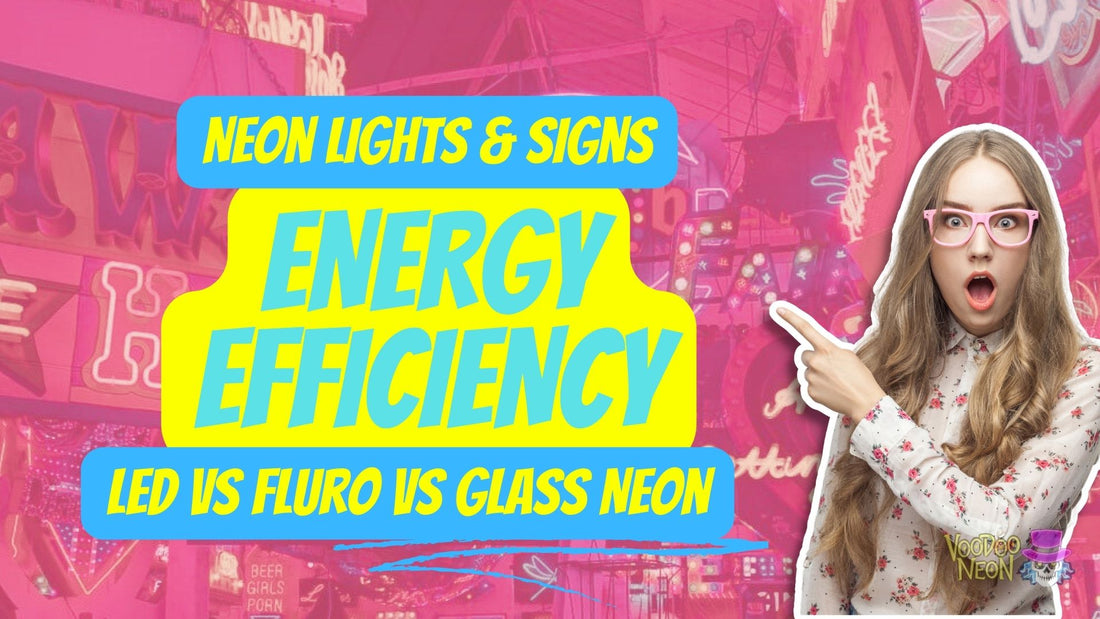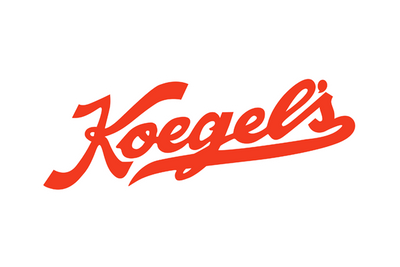
Energy Efficiency of Neon Signs & Lights
Chris DiproseShare
It's often said that LEDs are efficient, but how energy-efficient are they compared to their classic counterparts?
We often get asked this question, so I wanted to explore their energy efficiencies in this post and compare LED neon, fluorescent neon, and glass neon signs.
- Watts power - LED 150 watts, fluorescent 610 watts, and glass neon 400 watts.
- Power consumption (over 24 hours) - LED 1800 watts, fluorescent 7320 watts, and glass neon 4800 watts.
- Power consumption (over one year) - LED 657kw, fluorescent 2672kw, and glass neon 1752kw.
- In Colorado, per year, this would be - LED $80, fluorescent $325, and glass neon $213.
- In California, per year, this would be - LED $130, fluorescent $531, and glass neon $348
- The ongoing cost of LED is 1/7th the cost of fluorescent and 2/5th of glass neon.
So, let's explore the energy efficiency and power consumption of neon signs and lights in more detail.
The Comparison: LED vs Fluorescent vs Glass Tubes
For this comparison, I wanted to compare the most common lighting options for signage in the United States. I compared these 3 for power consumption and energy efficiency.
LED neon lights - these are made from LEDs (light-emitting diodes). I used LED neon flex for the comparison. These are used in LED neon signs.
Glass tube lights - these are made from glass neon tubing. The sealed glass tubes are filled with neon gas. The neon tube is mounted to a board and supplied with electrical current.
Fluorescent bulbs - these are the traditional fluorescent lighting you would have in most office and commercial buildings. They are also used in shop and retail signage.
I didn't consider incandescent bulbs, but these would be even worse than fluorescent bulbs.

Power Consumption Overview
The charts and results below compare the lights' energy draw, energy consumption over a 24-hour period and a 1-year period, the costs of running the lights for people in California and Colorado—based on current electricity prices—and the efficiency of converting electricity into light.
Power Draw
A typical LED neon light draws an electric current of 150 watts, whereas fluorescent and neon glass consumes around 610 watts and 400 watts, respectively.

Energy Consumed in 24 Hours
If we consider neon power consumption over 24 hours, the LED neon light consumes 1800 watts, the neon glass is 4,800 watts, and the fluorescent light consumes 7,320 watts.
Neon tubes are more energy-efficient than traditional fluorescent lights, but LED lighting is even more energy-efficient.

Energy Consumed in 1 Year
The same power consumption, calculated over the course of a year, is 657 KW for LED neon lights, 1752 KW for glass tubes, and 2672 KW for fluorescent lighting.
From this comparison, it's evident that LED neon signs are a more environmentally friendly option.

Running Costs
The current electricity rate in California is 19.9c per kw, and in Colorado, it is 12.1c per kw. Based on these rates, we can calculate the electricity cost for running each of the neon lights for one year.
The results are:
- Colorado (12.1c per kw): LED lights are $80, fluorescent lights are $325, and neon glass lights are $213.
- California (19.9c per kw): LED lights are $130, fluorescent lights are $531, and neon glass lights are $348.
LED is 1/7th the cost of fluorescent, and 2/5th the cost of running a neon light - LED is superior in energy consumption, and results in actual savings. Running a comparable design LED sign is less than half a third of the cost of a traditional neon sign.
Also of note is that California has high electricity costs compared to Colorado. Running the same LED neon sign in Colorado would be $50 cheaper per year compared to California.


Efficiency - Electricity to Light
It's often said that LEDs are more efficient than fluorescent and glass neon lights, but what does that actually mean?
LED neon signs convert 90% of electricity into light, with only 10% wasted.
Fluorescent lights convert 10% of electricity into light, wasting 90% (which is mainly given off as heat).
Glass neon lights convert 20% of electricity into light.
LED neon lights require less power, which means less energy is used, reducing the carbon footprint. It is for this very reason that LED lights are considered the most eco-friendly option for lighting.

LEDs convert 90% of electricity to light, glass neon converts 20% to light, and fluorescent converts 10% to light.
Conclusion
As I've covered, we can see that LED neon signs are more energy-efficient and cheaper to run.

FAQ about the Energy Efficiency of Lights
Are neon signs energy efficient?
Traditional neon signs use glass neon tubes, which convert electrical energy to light at a 20% conversion rate, which is substantially lower than that of more modern lights, like LED, which convert over 90% to light.
Is it expensive to run a neon sign?
To run a moderate-sized traditional neon sign in California costs $348, compared to equivalent LED neon signs costing $130.
In Colorado, for the same neon sign, it costs $348 to run and $130, respectively.
Are neon signs eco-friendly?
Traditional neon signs require 4x more energy to operate than an equivalent LED neon sign, resulting in a lower environmental impact.
Does a neon sign use a lot of electricity?
For a moderate-sized traditional neon sign, the electricity consumption for one year of use is 1752kw. An equivalent LED neon sign uses 657kw.
Is neon more efficient than LED?
Glass neon signs convert electrical energy to light at 20% efficiency, while LED neon signs convert at 90% efficiency.
LED neon signs are more efficient, require less electricity, and are cheaper to run, resulting in significant energy savings.







